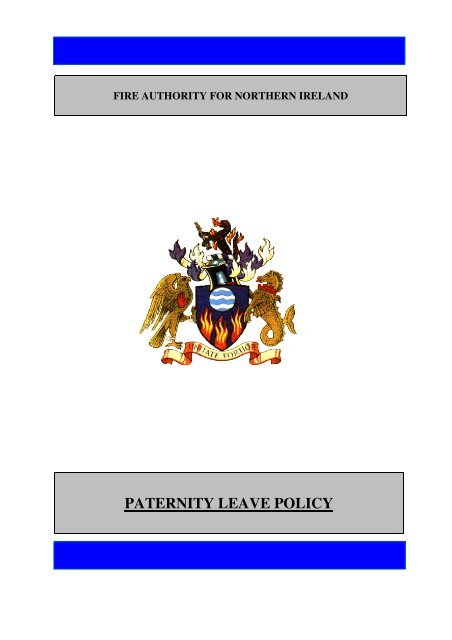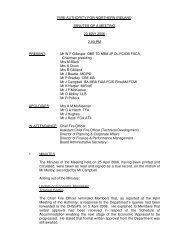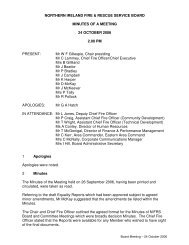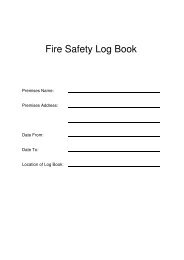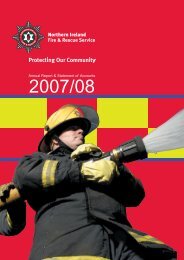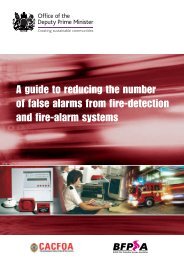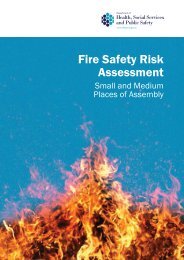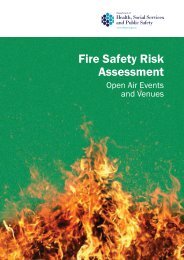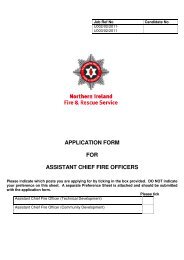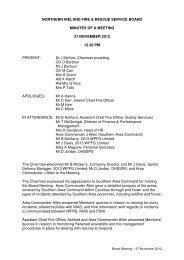PATERNITY LEAVE POLICY - Northern Ireland Fire & Rescue Service
PATERNITY LEAVE POLICY - Northern Ireland Fire & Rescue Service
PATERNITY LEAVE POLICY - Northern Ireland Fire & Rescue Service
You also want an ePaper? Increase the reach of your titles
YUMPU automatically turns print PDFs into web optimized ePapers that Google loves.
FIRE AUTHORITY FOR NORTHERN IRELAND<br />
<strong>PATERNITY</strong> <strong>LEAVE</strong> <strong>POLICY</strong>
FIRE AUTHORITY FOR NORTHERN IRELAND<br />
<strong>PATERNITY</strong> <strong>LEAVE</strong> <strong>POLICY</strong><br />
SECTION 1<br />
1.1 Introduction<br />
1.2 Policy Statement<br />
1.3 Aims<br />
1.4 Scope<br />
1.5 Equality of Opportunity<br />
1.6 Confidentiality and the Data Protection Act<br />
1.7 Reviewing the Policy<br />
1.8 Agreement with Representative Bodies<br />
1.9 Further Information and Guidance<br />
SECTION 2 – AN EMPLOYEE IS ELIGIBLE TO APPLY FOR <strong>PATERNITY</strong> <strong>LEAVE</strong><br />
SECTION 3 – AMOUNT AND TIMING OF <strong>LEAVE</strong><br />
SECTION 4 – NOTICE REQUIREMENTS<br />
SECTION 5 – ELIGIBILITY FOR STATUTORY <strong>PATERNITY</strong> PAY<br />
SECTION 6 – RIGHTS DURING <strong>PATERNITY</strong> <strong>LEAVE</strong><br />
SECTION 7 – RETURN TO WORK<br />
Issue Date: February 2005<br />
Revised:<br />
Issued By:<br />
Human Resources Policy Unit
FIRE AUTHORITY FOR NORTHERN IRELAND<br />
<strong>PATERNITY</strong> <strong>LEAVE</strong> <strong>POLICY</strong><br />
1.1 INTRODUCTION<br />
This Policy sets out the legislative requirements for paid paternity leave found in a<br />
number of different sources including the Employment (NI) Order 2002, the Paternity<br />
and Adoption Leave Regulations (NI) 2002 and the Statutory Paternity Pay and<br />
Statutory Adoption Pay (General) Regulations (NI) 2002.<br />
This Policy should be read in conjunction with the appropriate NJC Conditions of<br />
<strong>Service</strong> which apply to all uniformed and non-uniformed employees. Nothing in<br />
these paternity leave and pay provisions are to be construed as providing rights less<br />
favourable than statutory rights.<br />
1.2 <strong>POLICY</strong> STATEMENT<br />
The <strong>Fire</strong> Authority for <strong>Northern</strong> <strong>Ireland</strong> is committed to practices that support<br />
work-life balance and to equality of opportunity. The Authority recognises that<br />
employees are increasingly juggling a range of activities, interests and relationships<br />
outside work whilst striving to meet the increasing demands of the workplace. In<br />
order to support parents and in accordance with the Government Campaign for Work<br />
Life Balance, the Authority will provide greater opportunity to balance work and<br />
family life.<br />
1.3 AIMS<br />
The aim of this Policy is to ensure that employees know and understand their rights.<br />
1.4 SCOPE<br />
This Policy applies to employees of both sexes, uniformed and non-uniformed, at all<br />
<strong>Fire</strong> Authority for <strong>Northern</strong> <strong>Ireland</strong> locations when a child has been born or placed for<br />
adoption.<br />
In the case of birth, this Policy applies where the expected week of confinement<br />
(EWC) falls on or after 6 April 2003 or the child is born on or after 6 April 2003.<br />
In the cases of adoption, this Policy applies in respect of children matched or placed<br />
for adoption on or after 6 April 2003.<br />
1.5 EQUALITY OF OPPORTUNITY<br />
The <strong>Fire</strong> Authority for <strong>Northern</strong> <strong>Ireland</strong> is an equal opportunities employer. Requests<br />
for such leave under this Policy will be dealt with in accordance with our commitment<br />
to equal opportunity and within the exigencies of the service.<br />
Employees will be protected from being subjected to a detriment or dismissal for<br />
taking, or seeking to take such leave.
1.6 CONFIDENTIALITY AND THE DATA PROTECTION ACT<br />
All relevant parties will maintain confidentiality as appropriate. All records should be<br />
kept confidential and retained in accordance with the Data Protection Act 1998, which<br />
requires the release of certain data to individuals on their request.<br />
1.7 REVIEWING THE <strong>POLICY</strong><br />
The Human Resources Policy Unit will review this Policy periodically and in<br />
accordance with legislative changes. Consultation will be sought prior to any review<br />
with the appropriate Representative Bodies.<br />
1.8 AGREEMENT WITH REPRESENTATIVE BODIES<br />
This Policy has been circulated to and agreed by the Representative Bodies in the<br />
Brigade, namely the <strong>Fire</strong> Brigades’ Union, the <strong>Northern</strong> <strong>Ireland</strong> Public <strong>Service</strong><br />
Alliance, the Transport and General Workers Union and AMICUS – Amalgamated<br />
Engineering and Electrical Union.<br />
1.9 FURTHER INFORMATION AND GUIDANCE<br />
Further information and guidance can be obtained from the Human Resources<br />
Department at Brigade Headquarters.<br />
Copies of the National Joint Council for Local Government <strong>Service</strong>s National<br />
Agreement on Pay and Conditions of <strong>Service</strong> and National Joint Council for Local<br />
Authorities'<strong>Fire</strong> Brigades Scheme of Conditions of <strong>Service</strong> are available for<br />
inspection in the Human Resources Employee <strong>Service</strong>s Unit and the Library.<br />
2 AN EMPLOYEE IS ELIGIBLE TO APPLY FOR <strong>PATERNITY</strong> <strong>LEAVE</strong> IF:<br />
2.1 The employee has or expects to have responsibility for the baby’s upbringing<br />
and is either the biological father or the mother’s husband or partner (partner<br />
refers to someone who lives with the mother, either male or female, in an<br />
enduring family relationship, but who is not a blood relative); and<br />
2.2 The employee has worked continuously for the Authority for 26 weeks as at<br />
the 15 th week before the EWC and will continue in this employment up to the<br />
date of birth; and<br />
2.3 The employee is taking the time off for the purposes of either caring for the<br />
new baby or to support the mother.<br />
2.4 In addition to the above, the employee is eligible to apply for paternity leave<br />
where, in cases of adoption, the employee is the partner who does not avail of<br />
adoption leave.
3 AMOUNT AND TIMING OF <strong>LEAVE</strong><br />
3.1 Full-time employees may take up to ten consecutive working days leave (for<br />
employees conditioned to the shift duty system this will be eight duty shifts,<br />
for nine day fortnight employees; this will constitute nine days leave) and the<br />
leave must be taken consecutively, eg, in a block of one or two weeks. For<br />
Retained employees this will constitute two drill nights and unavailability for<br />
fire calls during the two-week Paternity Leave period. It should be noted that<br />
time off for Paternity Leave will not be included in any calculation of<br />
non-attendance at fire calls.<br />
3.2 Leave must be taken within 56 days of the birth, or, where the child is born<br />
earlier than expected, between the date of birth and 56 days from the first day<br />
of the EWC. Leave may start at any day of the week on or after the child's<br />
birth.<br />
4 NOTICE REQUIREMENTS<br />
4.1 An employee who wishes to take leave must notify in writing the appropriate<br />
Officer-in-Charge/Line Manager no later than the 15 th week before the<br />
expected week of confinement of the following:<br />
4.1.1 The date of the EWC;<br />
4.1.2 Whether the employee wishes to take one or two consecutive<br />
weeks/sets of leave;<br />
4.1.3 The date the Paternity Leave is to commence.<br />
4.2 The employee may change the commencement date provided the<br />
Officer-in-Charge/Line Manager is given at least 28 days'notice of the new<br />
start date, unless this is not reasonably practicable due to exceptional<br />
circumstances.<br />
4.3 The employee must inform the Officer-in-Charge/Line Manager of the date of<br />
the child’s birth as soon as practicable after the birth.<br />
The Officer-in-Charge/Line Manager is responsible for notifying the Human<br />
Resources Department of the Paternity Leave request as soon as it is received<br />
from the employee. An SC198 or SC199 form should be used for this<br />
purpose. Human Resources will write to the employee to acknowledge the<br />
request and may require the employee to forward a copy of the MATB1<br />
certificate belonging to the wife/partner confirming her pregnancy, once<br />
available.
5 ELIGIBILITY FOR STATUTORY <strong>PATERNITY</strong> PAY<br />
In addition to the eligibility criteria for Paternity Leave, the employee must have<br />
average weekly earnings at or above the Lower Earnings Limit for National Insurance<br />
as at the 15 th week before the EWC and must give the Authority at least 28 days’<br />
notice of their intention to claim Paternity Pay. It should be noted that, in the case of<br />
Retained employees, if National Insurance Contributions have been paid in the quarter<br />
preceding 15 weeks before the EWC, the two week Paternity Leave period will be<br />
paid at the prescribed rate of Statutory Paternity Pay or 90% of average weekly<br />
earnings (if less). Should their earnings in the quarter preceding 15 weeks before the<br />
EWC fall below the National Insurance Contributions limit, no Statutory Paternity<br />
Pay will be paid and the employee will be eligible to be paid a Retaining Fee and a<br />
Drill Fee only for the first week of Paternity Leave. The employee will be entitled to<br />
take a second week of Paternity Leave for which a Retaining Fee only will be paid.<br />
Due to the payment system for Retained personnel, the Statutory Paternity Pay will be<br />
paid at the time of taking the leave, less the Drill and Retaining Fee which will be<br />
paid at the end of the next quarter.<br />
For Wholetime, Control Room and full-time non-uniformed personnel, Statutory<br />
Paternity Pay is paid at the same prescribed rate as Statutory Maternity Pay or 90% of<br />
average weekly earnings (if less). However, given the existing provisions of<br />
Maternity Support Leave whereby a nominated carer of an expectant mother may<br />
avail of five days paid leave at or around the time of the birth, the Authority will pay<br />
the first week of Paternity Leave as if it were Maternity Support Leave, ie, at the<br />
employee’s standard weekly rate of pay and the second week of Paternity Leave will<br />
be at the prescribed rate of Statutory Paternity Pay only. It should be noted that<br />
Maternity Support Leave is distinct from Paternity Leave. The criteria and provisions<br />
of Maternity Support Leave are detailed in the Authority’s Maternity Support Leave<br />
Policy. The second week of Paternity Leave paid at the prescribed rate of Statutory<br />
Paternity Pay is superannuable and counts towards service.<br />
5.1 The employee must also give the Authority a signed declaration that the<br />
following criteria applies:<br />
✧ The employee is the father of the child and/or the husband or partner of the<br />
mother, as defined at 1 (a);<br />
✧ The leave is being taken to either care for the child or to support the<br />
mother; and<br />
✧ The employee has or expects to have responsibility for the upbringing of<br />
the child.<br />
6 RIGHTS DURING <strong>PATERNITY</strong> <strong>LEAVE</strong><br />
During Paternity Leave an employee is entitled to the benefit of all applicable terms<br />
and conditions of employment, except those relating to remuneration and to return to<br />
the same job.
7 RETURN TO WORK<br />
The employee is entitled to return to the same job on no less favourable terms and<br />
conditions.<br />
Requests from an employee for annual leave to be taken directly after Paternity Leave<br />
will, wherever possible, be met. These requests should be made with the prior<br />
agreement of the Officer-in-Charge/Line Manager and in accordance with the needs<br />
of the service. Where complications occur for either mother or child immediately<br />
following the birth, the Chief <strong>Fire</strong> Officer has the discretion to allow the use of<br />
Special Leave, with or without pay, to extend the statutory Paternity Leave period.


